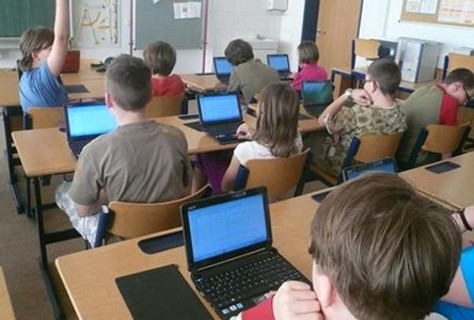Research conducted at 22 secondary schools provides guidelines for a better use of new technologies in the classroom
Research conducted at 22 secondary schools provides guidelines for a better use of new technologies in the classroom
Project “IES 2.0: Digital literacy practicals. Materials, classroom activities and online language resources”, coordinated by Daniel Cassany, professor of the Department of Translation and Language Sciences and investigator of the research group GR@EL of the UPF.
“Three or four years are needed for new technologies introduced to the classroom to finally normalize. Patterns of conduct, behaviour, require consolidating, since in many cases they are new tools for which there are no established habits”. So says Daniel Cassany, professor of the Department of Translation and Language Sciences at UPF and principal investigator of the project “IES 2.0: Digital literacy practicals. Materials, classroom activities and online language resources”.
Project IES 2.0 1x1, coordinated by UPF with the participation of the Autonomous University of Barcelona and the Universities of Girona and Lleida (with a total of fourteen researchers and four PhD students involved), aims to document, explore and interpret the changes caused by the introduction of laptops, WiFi, digital textbooks and virtual learning environments in the teaching of reading and writing in secondary education, in all areas.
Collecting, describing and analysing both the didactic materials (to see if they take advantage of the opportunities of the network) and students’ writings; describing and evaluating the reading and writing tasks to catalogue best practices, and identifying the linguistic technologies used by young people when reading and writing are the main objectives of the project, whose purpose is always to produce guidelines and recommendations for improvement.
Results for the schools
The research, carried out in between 1 January 2012 and 31 May 2015, collected more than 1,000 documents (written, audio and video recordings and images) from the participation of 22 secondary schools, grouped into four areas: the areas of Girona, Lleida, metropolitan area and province of Barcelona, and Barcelona city. All the centres took part in the 1x1 programme (EduCAT1x1 and EduCAT2.0), the Catalan Government’s project for classroom digitalization.
“In the first instance we have drafted a report on the results for the centres that participated in this ethnographic research, since we went there to interview students, teachers, and to collect data”, says Daniel Cassany. The researcher, who coordinates the Language Teaching and Learning Research Group (GR@EL) at UPF points out the findings of this first report: “It deals with issues related with reading and writing and touches on areas such as e-mail, social networks, note taking, the performance of tasks and the use of e-mail. We make a series of recommendations, generating concrete improvements and guiding policies for the centres to take advantage of in their day to day”.
What activities are done on paper and in digital format?
The report looks at which activities are done on paper and which have adapted to the digital format, with a computer, keyboard, access to network resources, etc., and what educational consequences this has on learning. It focuses on five specific points: reading, writing, digital language resources, digital communication (e-mail, virtual learning environments, Web 2.0), and social networks (Facebook, Instagram, WhatsApp).
The results suggest that the reading of a complete work is still done with a paper book, reading and writing activities combine paper and screen, and access to the network and its resources is limited. However, the use of social networks is widespread but peripheral, i.e. unofficial or unauthorised.
“The centres must work with the instruments that we use outside school. It doesn’t make sense that the tools we use outside cannot be used inside”, says Daniel Cassany. But, he adds: “we have to focus on issues related to the learning of academic, humanistic content of a certain rigour and quality”. “WhatsApp can be used to resolve specific questions, but it is not the right place to publish book review, for example”. Also, he explains that the mobile phone can be useful, but we must bear in mind that it can lead to distraction or, due to the small screens, difficulties of comprehension for students.
Recommendations for schools
Some of the recommendations around the five areas studied are that: searching for information on the web should be an ongoing activity in all subjects; access to the Internet should enrich the input and the teaching materials used in the classroom to read and write; students should be allowed to use laptops (or their technological equipment) in the way they want to for taking notes; we must promote cooperative digital writing tools and review and multilingualism tools, such as the automatic translator, dictionaries or language databases.
Other tips are to provide criteria and order when using e-mail; the acceptance of mobile phone as a resource that is present and useful in the classroom, with the consent of the teacher and the acceptance of the senate and/or the management of the centre, and clear and efficient rules for use and management resources available to all teachers; establish standards of behaviour in groups such as WhatsApp or Facebook, and make sure that the students use these networks with a school e-mail and separate their private life (their personal, leisure profile) from educational, school and curricular activity.
Other researchers linked to the GR@EL research group have also participated in the IES 2.0 1x1 project, which is part of the National Plan for Scientific Research, Development and Technological Innovation 2011, of the Spanish Ministry of Economy and Competitiveness: Carme Bach, Carmen López Ferrero, Josep Maria Castellà, Elena Merino (all UPF), Cristina Aliagas (The University of Sheffield) and Sílvia Llach (UdG), as well as the PhD students at UPF, Francisco Martínez Ortega, María José Valero and Boris Vázquez.
